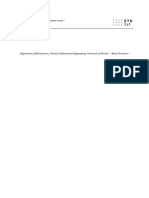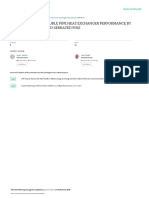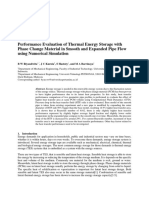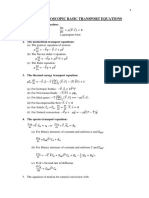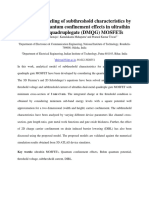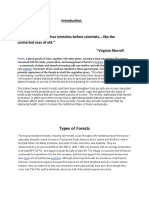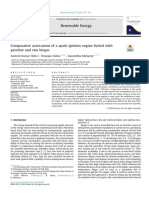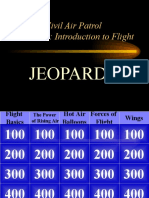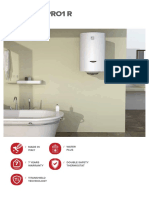Thermodynamic Nh3 H2o Mixture
Thermodynamic Nh3 H2o Mixture
Uploaded by
Hsein WangCopyright:
Available Formats
Thermodynamic Nh3 H2o Mixture
Thermodynamic Nh3 H2o Mixture
Uploaded by
Hsein WangOriginal Description:
Original Title
Copyright
Available Formats
Share this document
Did you find this document useful?
Is this content inappropriate?
Copyright:
Available Formats
Thermodynamic Nh3 H2o Mixture
Thermodynamic Nh3 H2o Mixture
Uploaded by
Hsein WangCopyright:
Available Formats
International Journal of Mechanical Engineering and Technology (IJMET)
Volume 8, Issue 8, August 2017, pp. 1430–1440, Article ID: IJMET_08_08_148
Available online at http://iaeme.com/Home/issue/IJMET?Volume=8&Issue=8
ISSN Print: 0976-6340 and ISSN Online: 0976-6359
© IAEME Publication Scopus Indexed
THERMODYNAMIC PROPERTY FUNCTIONS
OF NH3-H2O MIXTURE
K. Deepak
Department of Mechanical Engineering,
Vardhaman College of Engineering, Hyderabad, India
M. Ashok Kumar
Department of Mechanical Engineering,
Vardhaman College of Engineering, Hyderabad, India
V. Mahidhar Reddy
Department of Mechanical Engineering,
Institute of Aeronautical Engineering, Hyderabad, India
B. Subramanyam
Department of Mechanical Engineering,
MLR Institute of Technology, Hyderabad, India
ABSTRACT
The use of NH3-H2O mixture as working fluid in power cycle gives higher thermal
performance of power generating systems. The thermodynamic analysis and
simulation of NH3-H2O based power cycle require computation of thermodynamic
properties at various state points in the cycle. In this work, simple functions based on
Gibbs free energy for computing thermodynamic properties of NH3-H2O mixture have
been presented. Computer codes have been developed to compute the properties for
any given pressure, temperature and concentration of NH3 in the mixture. The results
have been validated by comparing with the values presented in the literature in
graphical form and are found to be reasonably accurate. The results are presented in
the form of charts are useful for the analysis of NH3-H2O based power and
refrigeration cycles.
Key words: NH3-H2O mixture, thermodynamic properties, simple functions, Gibbs
free energy, equilibrium properties.
Cite this Article: K. Deepak, M. Ashok Kumar, V. Mahidhar Reddy,
B. Subramanyam, Thermodynamic Property Functions of NH3-H2O Mixture,
International Journal of Mechanical Engineering and Technology 8(8), 2017, pp.
1430–1440.
http://iaeme.com/Home/issue/IJMET?Volume=8&Issue=8
http://iaeme.com/Home/journal/IJMET 1430 editor@iaeme.com
Thermodynamic Property Functions of NH3-H2O Mixture
1. INTRODUCTION
The analysis of NH3-H2O based power and refrigeration system need simple and efficient
functional forms to evaluate the thermodynamic properties of NH3-H2O mixture at various
conditions of pressure, temperature and concentration. Ziegler and Trepp [1] described an
equation for the thermodynamic properties of NH3-H2O mixture. They proposed Gibbs free
energy equation for determining the specific enthalpy, specific entropy and specific volume
and developed the properties up to a pressure of 50 bar and temperature of 227 °C. El-Sayed
and Tribus [2] have reviewed and extended data on properties of NH3-H2O mixture up to 316
°C and 210 bar. The maximum pressure for the correlations has been set to 115 bar which is
slightly above the critical pressure of ammonia Stecco and Desideri [3]. The critical pressure
and temperature of the mixture vary with the mass fraction of ammonia. Patek and Klomfar
[4] presented five simple equations to determine the vapour liquid equilibrium properties of
NH3-H2O mixture. Although the equations used by them are of completely empirical nature,
the results obtained are quite acceptable for industrial use up to 30 bar. Abovsky [5] used the
thermodynamic perturbation theory to determine the properties of pure substance and their
mixture for temperature up to 370 oC and pressure ranging from 0.2 to 230 bar. The deviation
from one-fluid approximation of the mixture has been studied considering the effects of
mixing enthalpy and volume. Xu and Goswami [6] used the Gibbs free energy for evaluating
equilibrium properties in combination with the bubble and dew point temperature. Nag and
Gupta [7] used the Peng-Robinson equation for vapor-liquid equilibrium and the Gibbs free
energy equations presented by Zielger and Trepp [1] for the vapor and liquid phase properties.
Barhoumi et al. [8] presented modelling of the thermodynamic properties. The values of
constants in the functions for the Gibbs excess energy have been recalculated with
experimental data at higher temperatures and pressures (up to 210 bar and 316 °C). Senthil
and Subbarao [9] presented fast calculation for determining enthalpy and entropy of the
mixtures. Ganesh and Srinivas [10] developed a flow chart to understand the computation of
the NH3-H2O mixture properties in Matlab.
The main objective of this work is to develop functional forms to facilitate the calculation
of the thermodynamic properties of NH3-H2O mixture for a wide range of temperature,
pressure and concentration through computer. In this work, the Gibbs free energy method is
considered for determining the properties of NH3-H2O mixture. The Gibbs free energy
equation form Ziegler and Trepp [1] has been utilized for determining the specific enthalpy,
specific entropy and specific volume of the NH3-H2O mixture. The bubble point and the dew
point of the mixture has been calculated by the correlations presented by Patek and Klomfar
[4] and Soleimani [11]. The Gibbs excess energy of liquid mixture is calculated from the
empirical relations proposed by Xu and Goswami [6]. The coefficients presented by Taleb et
al. [12] have been considered.
2. DERIVATIONS OF FUNCTIONS
2.1. Gibbs Free Energy
The Gibbs free energy of a pure substance has been derived considering the known
relations of volume and heat capacity as a function of temperature and pressure.
Equation (1) shows Gibbs free energy of a pure substance in integral form.
𝑇 𝑃 𝑇 𝐶𝑃
ℎ𝑂 − 𝑇𝑠𝑂 + ∫𝑇 𝐶𝑃 𝑑𝑇 + ∫𝑃 𝑣𝑑𝑃 − 𝑇 ∫𝑇 𝑑𝑇 (1)
𝑂 𝑂 𝑂 𝑇
The empirical correlations of heat capacity at constant pressure for the liquid and vapour
phase of both pure water and pure ammonia presented in [1] can be derived as:
http://iaeme.com/Home/journal/IJMET 1431 editor@iaeme.com
K. Deepak, M. Ashok Kumar, V. Mahidhar Reddy, B. Subramanyam
𝑣 𝑙 = 𝑎1 + 𝑎2 𝑃 + 𝑎3 𝑇 + 𝑎4 𝑇 2 (2)
𝑅𝑇 𝐶2 𝐶3 𝐶 4𝑇2
𝑣𝑔 = + 𝐶1 + + + (3)
𝑃 𝑇3 𝑇 11 𝑇 11
𝐶𝑃𝑙 = 𝑏1 + 𝑏2 𝑇 + 𝑏3 𝑇 2 (4)
𝑔 𝑃 𝜕2𝑣
𝐶𝑃 = 𝑑1 + 𝑑2 𝑇 + 𝑑3 𝑇 2 − ∫0 𝑂 ( 2 ) 𝑑𝑃 (5)
𝜕𝑇 𝑃
The Gibbs free energy for liquid and gaseous phase has been obtained by substituting the
values of v and CP from equations (2-5) in equation (1). For generalization the Gibbs free
energy at reduced state has been considered.
Liquid Phase:
𝐵2 𝐵3 𝑇𝑟
𝐺𝑟𝑙 = ℎ𝑟,𝑜
𝑙 𝑙
− 𝑇𝑟 𝑆𝑟,𝑜 + 𝐵1 (𝑇𝑟 − 𝑇𝑟,𝑜 ) + (𝑇𝑟2 − 𝑇𝑟,𝑜
2
)+ (𝑇𝑟3 − 𝑇𝑟,𝑜
3
) − 𝐵1 𝑇𝑟 𝑙𝑛 ( )
2 3 𝑇𝑟,𝑜
𝐵3
− 𝐵2 𝑇𝑟 (𝑇𝑟 − 𝑇𝑟,𝑜 ) − 𝑇 (𝑇 2 − 𝑇𝑟,𝑜
2
) + (𝐴1 + 𝐴3 𝑇𝑟 + 𝐴4 𝑇𝑟2 )(𝑃𝑟 − 𝑃𝑟,𝑜 )
2 𝑟 𝑟
𝐴2 2 2
+ (𝑃 − 𝑃𝑟,𝑜 )
2 𝑟
(6)
Gas Phase:
𝑔 𝑔 𝑔 𝐷2 𝐷3 𝑇𝑟
𝐺𝑟 = ℎ𝑟,𝑜 − 𝑇𝑟 𝑆𝑟,𝑜 + 𝐷1 (𝑇𝑟 − 𝑇𝑟,𝑜 ) + (𝑇𝑟2 − 𝑇𝑟,𝑜
2
)+ (𝑇𝑟3 − 𝑇𝑟,𝑜
3
) − 𝐷1 𝑇𝑟 𝑙𝑛 ( )
2 3 𝑇𝑟,𝑜
𝐷3 𝑃𝑟
− 𝐷2 𝑇𝑟 (𝑇𝑟 − 𝑇𝑟,𝑜 ) − 𝑇𝑟 (𝑇𝑟2 − 𝑇𝑟,𝑜
2
) + 𝑇𝑟 𝑙𝑛 ( ) + 𝐶1 (𝑃𝑟 − 𝑃𝑟,𝑜 )
2 𝑃𝑟,𝑜
𝑃𝑟 𝑃𝑟,𝑜 𝑃𝑟,𝑜 𝑇𝑟 𝑃𝑟 𝑃𝑟,𝑜 𝑃𝑟,𝑜 𝑇𝑟
+ 𝐶2 ( 3 − 4 3 + 3 4 ) + 𝐶3 ( 11 − 12 11 + 11 12 )
𝑇𝑟 𝑇𝑟,𝑜 𝑇𝑟,𝑜 𝑇𝑟 𝑇𝑟,𝑜 𝑇𝑟,𝑜
3 3 3
𝐶4 𝑃𝑟 𝑃𝑟,𝑜 𝑃𝑟,𝑜 𝑇𝑟
+ ( 11 − 12 11 + 11 12 )
3 𝑇𝑟 𝑇𝑟,𝑜 𝑇𝑟,𝑜
(7)
The reduced thermodynamic properties are:
𝑇 𝑃 𝐺 ℎ 𝑠 𝑣𝑃𝐵
𝑇𝑟 = , 𝑃𝑟 = , 𝐺𝑟 = , ℎ𝑟 = , 𝑠𝑟 = and 𝑣𝑟 =
𝑇𝐵 𝑃𝐵 𝑅𝑇𝐵 𝑅𝑇𝐵 𝑅 𝑅𝑇𝐵
http://iaeme.com/Home/journal/IJMET 1432 editor@iaeme.com
Thermodynamic Property Functions of NH3-H2O Mixture
Table 1 Coefficient Values of Equations (6-7)
Coefficient Water Ammonia
A1 3.971423.10-2 2.748796.10-2
A2 -1.790557.10-5 -1.016665.10-5
A3 -1.308905.10-2 -4.452025.10-3
A4 3.752836.10-3 8.389246.10-4
B1 1.634519.101 1.214557.101
B2 -6.508119 -1.898065
B3 1.448937 2.911966.10-1
C1 -1.049377.10-2 2.136131.10-2
C2 -8.288224 -3.169291.101
C3 -6.647257.102 -4.634611.104
C4 -3.045352.103 0
D1 3.673647 4.019170
D2 9.989629.10-2 -5.175550.10-2
D3 3.617622.10-2 1.951939.10-2
𝑙
ℎ𝑟,𝑜 4.878573 21.821141
𝑔
ℎ𝑟,𝑜 26.468879 60.965058
𝑙
𝑠𝑟,𝑜 1.644773 5.733498
𝑔
𝑠𝑟,𝑜 8.339026 13.453430
𝑇𝑟,𝑜 3.2252 5.0705
𝑃𝑟,𝑜 2 3
The values of the constants 𝑅, 𝑇𝐵 and 𝑃𝐵 are 8.314 kJ/kmol-K, 100 K and 10 bar
respectively. The values of coefficients Ai, Bi, Ci, and Di used in equations (6-7) are presented
in Table 1.
2.2. Thermodynamic Properties of Pure Component
The Gibbs free energy is related to the molar specific enthalpy, entropy and volume of a pure
component in terms of reduced variables as
http://iaeme.com/Home/journal/IJMET 1433 editor@iaeme.com
K. Deepak, M. Ashok Kumar, V. Mahidhar Reddy, B. Subramanyam
𝜕(𝐺𝑟 ⁄𝑇𝑟 )
ℎ = −𝑅𝑇𝐵 𝑇𝑟2 [ ] (8)
𝜕𝑇𝑟 𝑃𝑟
𝜕𝐺𝑟
𝑠 = −𝑅 [ ] (9)
𝜕𝑇𝑟 𝑃
𝑟
𝑅𝑇𝐵 𝜕𝐺𝑟
𝑣= − [ ] (10)
𝑃𝐵 𝜕𝑇𝑟 𝑃
𝑟
2.3. Thermodynamic Properties of NH3-H2O Mixture
The Gibbs free energy of NH3-H2O liquid mixture is obtained by adding the Gibbs excess
energy of the liquid mixture with the Gibbs free energy of the ideal solution mixture. The
deviation of NH3-H2O liquid mixture from ideal solution mixture is compensated by adding
Gibbs excess energy of the liquid mixture [1]. The Gibbs excess energy of liquid mixture is
determined by the empirical relations [6].
𝐺𝑟𝐸 = 𝑥(1 − 𝑥)[𝐹1 + 𝐹2 (2𝑥 − 1) + 𝐹3 (2𝑥 − 1)2 (11)
𝐸5 𝐸6
𝐹1 = 𝐸1 + 𝐸2 𝑃𝑟 + (𝐸3 + 𝐸4 𝑃𝑟 )𝑇𝑟 + + (12)
𝑇𝑟 𝑇𝑟2
𝐸11 𝐸12
𝐹2 = 𝐸7 + 𝐸8 𝑃𝑟 + (𝐸9 + 𝐸10 𝑃𝑟 )𝑇𝑟 + + (13)
𝑇𝑟 𝑇𝑟2
𝐸15 𝐸16
𝐹3 = 𝐸13 + 𝐸14 𝑃𝑟 + + (14)
𝑇𝑟 𝑇𝑟2
Table 2 Coefficient Values of Equations (12-14)
E1 -41.733398 E9 0.387983
E2 0.02414 E10 0.004772
E3 6.702285 E11 -4.648107
E4 -0.011475 E12 0.836376
E5 63.608967 E13 -3.553627
E6 -62.490768 E14 0.000904
E7 1.761064 E15 24.361723
E8 0.008626 E16 -20.736547
The Coefficients for equations (12-14) have been taken from Taleb et al. [12] and are
given in Table 2. The excess specific enthalpy, entropy and volume of the liquid mixture are
given by the following equations.
𝜕(𝐺𝑟𝐸 ⁄𝑇𝑟 )
ℎ𝐸 = −𝑅𝑇𝐵 𝑇𝑟2 [ ] (15)
𝜕𝑇𝑟 𝑃𝑟
𝜕𝐺𝑟𝐸
𝑠 𝐸 = −𝑅 [ ] (16)
𝜕𝑇𝑟 𝑃
𝑟
http://iaeme.com/Home/journal/IJMET 1434 editor@iaeme.com
Thermodynamic Property Functions of NH3-H2O Mixture
𝑅𝑇𝐵 𝜕𝐺𝑟𝐸
𝑣𝐸 = − [ ] (17)
𝑃𝐵 𝜕𝑇𝑟 𝑃
𝑟
Therefore, the specific enthalpy, entropy and volume of the liquid mixture are given as:
𝑙 𝑙 𝑙
ℎ𝑚 = 𝑥ℎ𝑁𝐻3
+ (1 − 𝑥)ℎ𝐻 2𝑂
+ ℎ𝐸 (18)
𝑙
𝑙
𝑠𝑚 = 𝑥𝑠𝑁𝐻3
+ (1 − 𝑥)𝑠𝐻𝑙 2 𝑂 + 𝑠 𝐸 + 𝑠 𝑚𝑙 (19)
𝑙
𝑙
𝑣𝑚 = 𝑥𝑣𝑁𝐻3
+ (1 − 𝑥)𝑣𝐻𝑙 2 𝑂 + 𝑣 𝐸 (20)
𝑠 𝑚𝑙 = −𝑅[𝑥𝑙𝑛(𝑥) + (1 − 𝑥) ln(𝑙 − 𝑥)] (21)
The specific enthalpy, entropy and volume of the vapour mixture is also obtained in the
similar way but since the NH3-H2O vapour mixture nearly forms an ideal solution, the Gibbs
excess energy for the vapour mixture is assumed to be zero.
𝑔 𝑔 𝑔
ℎ𝑚 = 𝑦ℎ𝑁𝐻3 + (1 − 𝑦)ℎ𝐻2 𝑂 (22)
𝑔 𝑔 𝑔
𝑠𝑚 = 𝑦𝑠𝑁𝐻3 + (1 − 𝑦)𝑠𝐻2 𝑂 + 𝑠 𝑚𝑔 (23)
𝑔 𝑔 𝑔
𝑣𝑚 = 𝑦𝑣𝑁𝐻3 + (1 − 𝑦)𝑣𝐻2 𝑂 (24)
𝑠 𝑚𝑔 = −𝑅[𝑦𝑙𝑛(𝑦) + (1 − 𝑦) ln(𝑙 − 𝑦)] (25)
2.4. Bubble and Dew Point Temperatures
It is assumed that, in the gas phase above the saturation temperature of water the superheated
NH3-H2O mixture behaves as an ideal solution. When the temperature is between the pure
water saturation temperature and the mixture dew point Td, in the gas phase, the water
component is assumed in a meta-stable vapour state at the considered pressure. Similarly, in
the liquid region, between the saturation temperature of pure ammonia and the bubble point of
the mixture Tb, a meta-stable liquid state for ammonia is assumed. In the wet vapour mixture
region Td > T > Tb we have a saturated vapour mixture with ammonia mass fraction x and a
saturated liquid mixture with ammonia mass fraction y. In the liquid region, below the bubble
point of the mixture Tb, a Gibbs excess function for the departure from ideal-solution
behaviour is assumed.
𝑃 𝑛𝑖
𝑇𝑏 (𝑝, 𝑥) = 𝑇𝑜 ∑𝑖 𝑎𝑖 (1 − 𝑥)𝑚𝑖 [𝑙𝑛 ( 𝑜 )] (26)
𝑃
𝑚⁄ 𝑃 𝑛𝑖
𝑇𝑑 (𝑝, 𝑦) = 𝑇𝑜 ∑𝑖 𝑎𝑖 (1 − 𝑦) 4 [𝑙𝑛 ( 𝑜 )] (27)
𝑃
𝑑
𝑦(𝑥, 𝑃) = 1 − exp [𝑎𝑃𝑏 𝑥 + (𝑐 + ) 𝑥 2 ] (28)
𝑃
The bubble point and dew point temperatures of the NH3-H2O mixture are evaluated using
the equations (26-27) given by Patek and Klomfar [4] and equation (28) presented by
Soleimani [11]. The variation of bubble point and dew point temperatures with ammonia-
mole fraction up to 110 bar is shown in Fig. 1.
http://iaeme.com/Home/journal/IJMET 1435 editor@iaeme.com
K. Deepak, M. Ashok Kumar, V. Mahidhar Reddy, B. Subramanyam
600
550
500
110 bar
450 90 bar
70 bar
Temperature (K)
50 bar
400
30 bar
350 10 bar
300
1 bar
0.5 bar
250 0.2 bar
200
0 0.1 0.2 0.3 0.4 0.5 0.6 0.7 0.8 0.9 1
Ammonia Mass Fraction
Figure 1 Variation of bubble point and dew point temperatures with ammonia mass fraction up to 110 bar
3. RESULTS AND DISCUSSIONS
3.1. Specific Enthalpy of NH3-H2O Mixture in Liquid Phase
1100
Present work
1000 Xu and Goswami (1999)
900
Specific Enthalpy (kJ/kg)
800
700
600
500
400
300
200
0 0.1 0.2 0.3 0.4 0.5 0.6 0.7 0.8 0.9 1
Ammonia mass fraction
Figure 2 Specific enthalpy of saturated NH3H2O solution at 34.47 bar
The specific enthalpy and entropy of the NH3-H2O mixture both in liquid and vapour
phase is calculated from equations (18-24). Fig. 2 shows the variation of specific enthalpy of
saturated liquid with ammonia mass fraction at 34.47 bar pressure. The results closely match
with the results of Xu and Goswami [6]. The maximum error is found to be 2.7%.
Considering the high value of pressure, this deviation may be allowed for specific calculation.
It is clear that the specific enthalpy of liquid mixture decreases with ammonia mass fraction
up to a certain point. This is due to the fact that the specific enthalpy of water is much higher
than that of liquid ammonia and as the mass fraction of water decreases slowly with the
increase of mass fraction of ammonia, the specific enthalpy decreases. After a certain point
the specific enthalpy increases with ammonia mass fraction. This is because the excess
http://iaeme.com/Home/journal/IJMET 1436 editor@iaeme.com
Thermodynamic Property Functions of NH3-H2O Mixture
enthalpy due to mixing of the two liquids becomes predominant and increases the specific
enthalpy of the mixture.
3.2. Specific Enthalpy of NH3-H2O Mixture in Vapour Phase
2900
Present work
2700 Xu and Goswami (1999)
Specific Enthalpy (kJ/kg)
2500
2300
2100
1900
1700
1500
1300
1100
0 0.1 0.2 0.3 0.4 0.5 0.6 0.7 0.8 0.9 1
Ammonia mass fraction
Figure 3 Specific enthalpy of saturated NH3H2O vapour mixture at 34.47 bar
Fig. 3 shows the variation of specific enthalpy of saturated vapour with mass fraction of
ammonia at 34.47 bar pressure. The results are compared with the results of Xu and Goswami
[6] and are seen to be consistent. The maximum error is found to be 3.4 %. The enthalpy
value decreases continuously with the increase in the concentration.
3.3. Specific Entropy of NH3-H2O Mixture in Liquid Phase
Fig. 4 shows the variation of specific entropy of saturated vapour with ammonia mass fraction
at 37 bar. The computed values of entropy show a good agreement with the data published in
literature [6]. The deviation is nominal and is found to be 4.2%.
4
Present work
Xu and Goswami (1999)
Specific Entropy, kJ/kg-K
0 0.1 0.2 0.3 0.4 0.5 0.6 0.7 0.8 0.9 1
Ammonia mass fraction
Figure 4 Specific entropy of saturated NH3H2O solution at 37 bar
http://iaeme.com/Home/journal/IJMET 1437 editor@iaeme.com
K. Deepak, M. Ashok Kumar, V. Mahidhar Reddy, B. Subramanyam
3.4. Specific Entropy of NH3-H2O Mixture in Vapour Phase
The variation of specific entropy of saturated vapour with ammonia mass fraction at 37 bar
has been presented in Fig. 5. The computed values of entropy show a good agreement with
the values presented in literature [6]. The deviation is nominal and is found to be 4.9%.
8
Present work
Xu and Goswami (1999)
7
Specific Entropy, kJ/kg-K
3
0 0.1 0.2 0.3 0.4 0.5 0.6 0.7 0.8 0.9 1
Ammonia mass fraction
Figure 5 Specific entropy of saturated NH3H2O vapour mixture at 37 bar
4. CONCLUSIONS
The equations presented in this paper, combines the Gibbs free energy method for the mixture
properties and the bubble and dew point temperature equations for the phase equilibrium. The
merit of these fast approximation equations include their simplicity, which facilitates to be
used in any computer code. When employed in this alternative way, they provide a substantial
reduction in the number of iterations. The equations are valid for a wide range of temperature
and pressure (230<T<600 K and 0.2<P<110 bar). A computer code has been developed to
generate thermodynamic properties of ammonia water mixture for both liquid and vapour
phase.
The computed results obtained by this work are validated by comparing with the
published data in the literature. The graphs obtained from this work, show a very close trend
of comparison. The maximum error for the enthalpy at 34.47 bar is found to be 2.7% for
saturated liquid and for saturated vapour at the same pressure of 34.47 is found to be 3.4%.
The deviation of saturated specific entropy of the liquid and vapour mixture is found to be
slightly higher with a maximum error of 4.2% and 4.9% at the same pressure 37 bar. Though
the graphs show some variation but it is quite acceptable as the pressure is quite high. Thus
the data generated can be used further for the analysis of NH3-H2O based refrigeration and
power generating systems.
NOMENCLATURE
P pressure (bar)
T temperature (°C)
v molar specific volume (m3kmol-1)
h molar specific enthalpy (kJkmol-1)
http://iaeme.com/Home/journal/IJMET 1438 editor@iaeme.com
Thermodynamic Property Functions of NH3-H2O Mixture
s molar specific Entropy (kJkmol-1K-1)
R molar gas constant (kJkmol-1 K-1)
CP heat capacity at constant pressure (kJkg-1K-1)
x ammonia mole fraction in liquid phase
y ammonia mole fraction in vapour phase
a, b, c, d coefficients
A, B, C, D, E, F dimensionless coefficients
REFERENCES
[1] Ziegler, B. and Trepp, C., Equation of state for ammonia-water mixtures. International
journal of refrigeration, 7, 1984, 101-106.
[2] El-Sayed, Y. M., Tribus, M., Thermodynamic properties of water-ammonia mixtures
theoretical implementation for use in power cycles analysis, ASME AES1, 1985, 89-95.
[3] Stecco, S. S. and Desideri, U., Consideration on the design principles for a binary
mixture heat recovery boiler, Journal of engineering for gas turbines and power, 114-
4, 1992, 701-706.
[4] J. Patek and J. Klomfar, Simple functions for fast calculations of selected
thermodynamic properties of the ammonia-water system, Refrigeration, 18, 1995, 228-
234.
[5] Abovsky, V., Thermodynamics of ammonia-water mixture, Fluid phase equilibria, 116,
1995, 170-176.
[6] Xu, F. and Goswami, D.Y., Thermodynamic properties of ammonia water mixtures for
use in power cycles. Energy, 24, 1999, 525-536.
[7] Nag, P.K., Gupta, Exergy analysis of the Kalina cycle, Applied thermal Engineering, 18-6,
1997, 427-439.
[8] Barhoumi, M. A., Snoussi, N., Ezzine, B., Mejbri, K.H. and Bellagi, A., Modelling of
the thermodynamic properties of the ammonia/water mixture, International journal of
refrigeration, 27, 2004, 271- 283.
[9] Senthil R, Murugan PMV, Subbarao, Thermodynamic analysis of Rankine-Kalina
combined cycle”, International Journal of Thermodynamics, 11, 2008, 133-141.
[10] N. Shankar Ganesh and T. Srinivas, Journal of mechanical engineering research 3-1, 2011,
25-39.
[11] G. Soleimani Alamdari, Simple functions for predicting the thermodynamic properties of
ammonia-water mixture, 20(1), 2007, 95-104.
[12] Taleb, A. H., Feidt, M. and Lottin, O., Thermodynamic properties of ammonia-water
mixture, Proceedings, International congress of refrigeration, Washington D.C., 2003,
ICR0113.
[13] Dr. CH V K N S N Moorthy, K Bharadwajan and Dr. V Srinivas , Computational St
udies on Aero -Thermodynamic Design and Performance of Centrifugal Turbo -
http://iaeme.com/Home/journal/IJMET 1439 editor@iaeme.com
K. Deepak, M. Ashok Kumar, V. Mahidhar Reddy, B. Subramanyam
Machinery . International Journal of Mechanical Engineering and Technology, 8(5),
2017 , pp. 320 –333
[14] Abhinav Kumar, Sarbjeet Singh, Ramesh Chand, Vishnu Saini and Raja Sekhar
Dondapati, Temperature Dependent Thermo dynamic Properties of Diesel Fuel
Surrogate at Critical Pressure for Combustion Modeling in Compression Ignition
Engines. International Journal of Mechanical Engineering and Technology, 8(7),
2017, pp. 1492–1499.
[15] Abhinav Kumar, Sarbjeet Singh, Ramesh Chand, Vishnu Saini and Raja Sekhar
Dondapati, Temperature Dependent Thermo dynamic Properties of Diesel Fuel
Surrogate at Critical Pressure for Combustion Modeling in Compression Ignition
Engines. International Journal of Mechanical Engineering and Technology, 8(7),
2017, pp. 1492–1499.
http://iaeme.com/Home/journal/IJMET 1440 editor@iaeme.com
You might also like
- CHEM 111.1 Exercise 2Document13 pagesCHEM 111.1 Exercise 2paradoxcomplexNo ratings yet
- Eosc 114 Earthquakes Multiple ChoiceDocument52 pagesEosc 114 Earthquakes Multiple Choicemgupta72No ratings yet
- Inverted Pendulum - A System With Innumerable ApplicationsDocument12 pagesInverted Pendulum - A System With Innumerable ApplicationsMattia PolgaNo ratings yet
- Journal Pre-Proofs: Results in PhysicsDocument25 pagesJournal Pre-Proofs: Results in PhysicsDr. Sushant ShekharNo ratings yet
- COBEM 2021 - Luciene - 32587Document9 pagesCOBEM 2021 - Luciene - 32587Paulo TrevizoliNo ratings yet
- IMSEGECDocument12 pagesIMSEGECzhor El hallaouiNo ratings yet
- 2155 13572 1 PBDocument8 pages2155 13572 1 PBIliace ArbaouiNo ratings yet
- Sheet 1. Stress AnalysisDocument3 pagesSheet 1. Stress AnalysisAhmed WailNo ratings yet
- MEG506 - Exam - 2020 - 21 - Model Answers and Marking SchemeDocument6 pagesMEG506 - Exam - 2020 - 21 - Model Answers and Marking Schemeajahbenjamin1No ratings yet
- Introduction VenturiDocument8 pagesIntroduction VenturiRoger FernandezNo ratings yet
- Chemical Reactions: Natural Gas Pyrolysis (NGP)Document7 pagesChemical Reactions: Natural Gas Pyrolysis (NGP)GiselleVazquezNo ratings yet
- Tubular Reactor With Side InjectionsDocument17 pagesTubular Reactor With Side InjectionsMohamad Abou DaherNo ratings yet
- 10.2478 - Scjme 2023 0013Document10 pages10.2478 - Scjme 2023 0013ferdinand.axiaNo ratings yet
- Computational Multicore On Two-Layer 1D Shallow Water Equations For Erodible DambreakDocument15 pagesComputational Multicore On Two-Layer 1D Shallow Water Equations For Erodible DambreakBayu AkbarNo ratings yet
- Heat Transfer of Double Pipe Heat Exchanger Performance by Using Nanofluids and Serrated FinsDocument12 pagesHeat Transfer of Double Pipe Heat Exchanger Performance by Using Nanofluids and Serrated FinsnabeelNo ratings yet
- Performance Evaluation of Thermal Energy Storage With Phase Change Material in Smooth and Expanded Pipe Flow Using Numerical SimulationDocument8 pagesPerformance Evaluation of Thermal Energy Storage With Phase Change Material in Smooth and Expanded Pipe Flow Using Numerical SimulationAklilu BahetaNo ratings yet
- Assignment 6Document3 pagesAssignment 6sourav gangulyNo ratings yet
- Improvement of Aerodynamic Performance of An Aircraft Using Morphing WingDocument15 pagesImprovement of Aerodynamic Performance of An Aircraft Using Morphing Wingİhsan Alp OzdemirNo ratings yet
- S9-P5 Mrabti PaperDocument10 pagesS9-P5 Mrabti PaperGhita ZazNo ratings yet
- Pat 222Document6 pagesPat 222digvijay singhNo ratings yet
- Assignment 5Document3 pagesAssignment 5lrayshadNo ratings yet
- Assignment 5Document3 pagesAssignment 5lrayshadNo ratings yet
- Assignment 5Document3 pagesAssignment 5lrayshadNo ratings yet
- BS10003 Iit KGPDocument7 pagesBS10003 Iit KGPGokulNo ratings yet
- Table-1: Microscopic Basic Transport Equations: 1. The Continuity EquationDocument11 pagesTable-1: Microscopic Basic Transport Equations: 1. The Continuity EquationABDUL RAFEYNo ratings yet
- MOS Lecture 06Document15 pagesMOS Lecture 06Usama AliNo ratings yet
- Lesson 16 Stress Transformation (Mohr Circle)Document4 pagesLesson 16 Stress Transformation (Mohr Circle)Joshua John JulioNo ratings yet
- EquationsDocument4 pagesEquationsNeshen Joy Saclolo CostillasNo ratings yet
- Condensation and Boiling Heat TransferDocument11 pagesCondensation and Boiling Heat TransferChemical EngineeringNo ratings yet
- Materials Science Journal 06 NOVDocument9 pagesMaterials Science Journal 06 NOVnaresh kotraNo ratings yet
- Development of New Code For AHWRDocument4 pagesDevelopment of New Code For AHWRvgautambarcNo ratings yet
- Hydrology Exam Questions SampleDocument5 pagesHydrology Exam Questions Sampleoshani adikaramNo ratings yet
- Partially Depleted and Fully Depleted Silicon On Insulator: A Comparative Study Using TCADDocument3 pagesPartially Depleted and Fully Depleted Silicon On Insulator: A Comparative Study Using TCADRamavath RajenderNo ratings yet
- Assignment I_Econometrics I_2024Document2 pagesAssignment I_Econometrics I_2024girumtmr1996No ratings yet
- 2020 May - June PHY3703 - P1 - ExamDocument3 pages2020 May - June PHY3703 - P1 - ExamTevin DeepchundNo ratings yet
- IJRAH2022020309Document7 pagesIJRAH2022020309Johanes olo tua ManullangNo ratings yet
- 2020 Oct - Nov PHY3703 EPDocument3 pages2020 Oct - Nov PHY3703 EPTevin DeepchundNo ratings yet
- The Exam Is Closed Book and Closed NotesDocument6 pagesThe Exam Is Closed Book and Closed NotesPengintaiNo ratings yet
- PLASTIC Material DervitiveDocument7 pagesPLASTIC Material DervitiveAshraf AlsalmaniNo ratings yet
- Soliton Solutions of DSW and Burgers Equations byDocument31 pagesSoliton Solutions of DSW and Burgers Equations byNibRazNo ratings yet
- CIT3111 Thermodynamics: Chemical Engineering III 2016: Test 2Document8 pagesCIT3111 Thermodynamics: Chemical Engineering III 2016: Test 2TKNo ratings yet
- Unit-2 Vector CalculusDocument86 pagesUnit-2 Vector CalculusRitesh MukhNo ratings yet
- 2579-Manuscript With Authors Details-12141-1-10-20201215Document14 pages2579-Manuscript With Authors Details-12141-1-10-20201215Vasant PhirkeNo ratings yet
- ENGMEC2 Problem Set 2Document12 pagesENGMEC2 Problem Set 2ArchRussellGonzalesNo ratings yet
- Ijmet: ©iaemeDocument10 pagesIjmet: ©iaemeIAEME PublicationNo ratings yet
- Mathematical AnalysisDocument2 pagesMathematical AnalysisShafqat HussainNo ratings yet
- Inverted Pendulum: A System With Innumerable Applications: March 2017Document13 pagesInverted Pendulum: A System With Innumerable Applications: March 2017LUIS NAVARRO MORENONo ratings yet
- 2nd ExamDocument6 pages2nd ExamMostafa TarekNo ratings yet
- Exam 2 PDFDocument6 pagesExam 2 PDFMustafa Abd ElhamidNo ratings yet
- Failure Analysis of Composites Plate With Central Opening Hole Subject To Arbitrary Tension LoadDocument12 pagesFailure Analysis of Composites Plate With Central Opening Hole Subject To Arbitrary Tension LoadSajjid Hasan Asif PanthoNo ratings yet
- Analytical Modeling of Quadruple Gate MOSFETDocument16 pagesAnalytical Modeling of Quadruple Gate MOSFETVishu RaoNo ratings yet
- Formulation of A Mode I Crack Propagation Model by Analyzing The Stress Field at The Crack TipDocument12 pagesFormulation of A Mode I Crack Propagation Model by Analyzing The Stress Field at The Crack TipIJAR JOURNALNo ratings yet
- Relatório Mecânica Dos Fluidos IDocument24 pagesRelatório Mecânica Dos Fluidos IMatheus BassoNo ratings yet
- ME305 EndSemKEY 22112017Document3 pagesME305 EndSemKEY 22112017sameerakhatoon05No ratings yet
- CIEM 5390 Lecture Notes Set 5Document26 pagesCIEM 5390 Lecture Notes Set 5lastbald3No ratings yet
- Single-Stage GearboxDocument21 pagesSingle-Stage Gearboxapi-469023149No ratings yet
- Logical progression of twelve double binary tables of physical-mathematical elements correlated with scientific-philosophical as well as metaphysical key concepts evidencing the dually four-dimensional basic structure of the universeFrom EverandLogical progression of twelve double binary tables of physical-mathematical elements correlated with scientific-philosophical as well as metaphysical key concepts evidencing the dually four-dimensional basic structure of the universeNo ratings yet
- Pampid T80a ModifiedDocument1 pagePampid T80a ModifiedHsein WangNo ratings yet
- 10603Document223 pages10603Hsein WangNo ratings yet
- Natural Gas Boiler CalculationsDocument691 pagesNatural Gas Boiler CalculationsHsein WangNo ratings yet
- So2 and nh3 ReactionDocument2 pagesSo2 and nh3 ReactionHsein WangNo ratings yet
- Script Go Green WeekendDocument3 pagesScript Go Green WeekendNgô Tấn DũngNo ratings yet
- Bab 4 - LNGDocument64 pagesBab 4 - LNGSatria KenariNo ratings yet
- The Organization of The Periodic Table Directions: 18 GroupsDocument7 pagesThe Organization of The Periodic Table Directions: 18 GroupsArin ATANo ratings yet
- Imp of ForestDocument8 pagesImp of ForestShikha GuptaNo ratings yet
- CH 6 ReviewDocument5 pagesCH 6 Reviewsabi a100% (1)
- Chapter 2Document29 pagesChapter 2Bilal shahzadNo ratings yet
- Renewable Energy: Santosh Kumar Hotta, Niranjan Sahoo, Kaustubha MohantyDocument13 pagesRenewable Energy: Santosh Kumar Hotta, Niranjan Sahoo, Kaustubha Mohantyluis romero morenoNo ratings yet
- Resources and Development NotesDocument27 pagesResources and Development NotesbhaviknsrNo ratings yet
- You Can Do It-Homeroom GuidanceDocument3 pagesYou Can Do It-Homeroom GuidanceAnonymousNo ratings yet
- Assignment1 Solutions - KNLDocument6 pagesAssignment1 Solutions - KNLsaraNo ratings yet
- Brosura PlasticDocument2 pagesBrosura PlasticAlexandru MuntoiuNo ratings yet
- Cambridge IGCSE: CHEMISTRY 0620/04Document16 pagesCambridge IGCSE: CHEMISTRY 0620/04Yasir Akhun0% (1)
- A "Green" Building Is Not Always "Sustainable": Guided By: Submitted byDocument20 pagesA "Green" Building Is Not Always "Sustainable": Guided By: Submitted byKaur SimranNo ratings yet
- Flash Steam Important ArticleDocument14 pagesFlash Steam Important ArticleAhmad Riaz Khan100% (1)
- ESS Paper 2 Markscheme N17Document20 pagesESS Paper 2 Markscheme N17dzdqqbrnztNo ratings yet
- Chap 6 Extra Short QuesDocument6 pagesChap 6 Extra Short QuesmariaNo ratings yet
- Distri Generation CubaDocument5 pagesDistri Generation CubaFátima OliveiraNo ratings yet
- 09 - Gas Absorber DesidnDocument19 pages09 - Gas Absorber DesidnNoman Aslam100% (1)
- Daftar Istilah RJPPDocument6 pagesDaftar Istilah RJPPAyu GantariNo ratings yet
- Chemistry Level L-Chapter 2 BQ-2324-PPPDocument3 pagesChemistry Level L-Chapter 2 BQ-2324-PPPnextfodenNo ratings yet
- Heat Rate Test / Performance Test of Power PlantsDocument6 pagesHeat Rate Test / Performance Test of Power PlantsSumaira Khan100% (1)
- September 2007 Geo-Heat Center Quarterly BulletinDocument28 pagesSeptember 2007 Geo-Heat Center Quarterly BulletinGeo-Heat Center Quarterly BulletinNo ratings yet
- Wave Power Persuasive SpeechDocument15 pagesWave Power Persuasive SpeechSummer BiggsNo ratings yet
- Jeopardy Module 1 CAP 55163C26AE208Document106 pagesJeopardy Module 1 CAP 55163C26AE208amerNo ratings yet
- Presentasi Bahasa InggrisDocument6 pagesPresentasi Bahasa InggrisAndriani SilfianaNo ratings yet
- Ariston EWH PRO1 R ModelDocument3 pagesAriston EWH PRO1 R Modelkarim tarekNo ratings yet
- Annex 3 - Post-Shredder Technologies - Review of The Technologies and CostsDocument27 pagesAnnex 3 - Post-Shredder Technologies - Review of The Technologies and CostsJose Luis MoltoNo ratings yet
- Chapter IV - Biodiversity and Healthy SocietyDocument26 pagesChapter IV - Biodiversity and Healthy SocietyJasmine Pagligaran75% (4)
- Sustainable Energy Technology - DelftDocument4 pagesSustainable Energy Technology - DelftAlquiorra SchifferNo ratings yet












